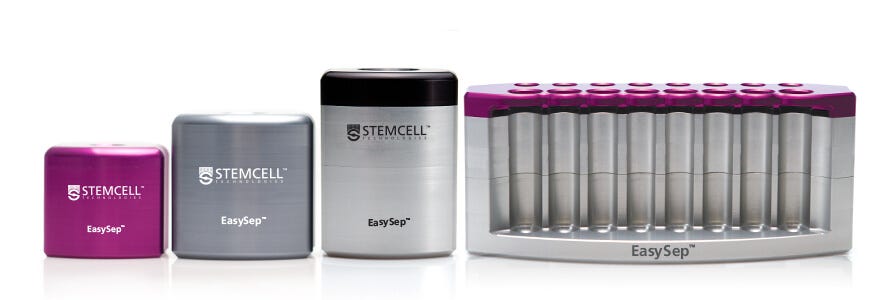How to Prepare a Single-Cell Suspension from Mouse Spleen Prior to Dendritic Cell Isolation
This protocol describes how to prepare a single-cell suspension of splenocytes prior to performing isolation of specific dendritic cell (DC) subsets. Depending on the DC subset you want to isolate downstream, the optimal spleen dissociation protocol may differ slightly from the procedure described below. Check the EasySepÔäó kit-specific Product Information Sheet for the recommended information.
Materials
- 60 mm Treated Tissue Culture Dishes (Catalog #27120)
- Spleen Dissociation Medium (Catalog #07915)
- 3 cc Syringes (Catalog #28230)
- 50 mL conical tube (e.g. Falcon® Conical Tubes, 50 mL, Catalog #38010)
- 70 ╬╝m cell strainer (e.g. 70 ┬Ám Reversible Strainer, Large, Catalog #27260)
- 5 or 10 mL serological pipette (e.g. Falcon® Serological Pipettes, 5 mL, Catalog #38003, or Falcon® Serological Pipettes, 10 mL, Catalog #38004)
- Optional: DNase 1 Solution (1 mg/mL, Catalog #07900)
Protocol
Part I: Enzymatic dissociation of a Mouse Spleen Sample
- Transfer 1 - 2 freshly-harvested spleens to be processed into a sterile 60 mm culture dish. Trim any extra connective tissues or fat from the spleen, take note of any necrotic regions, and inspect the spleen for any other phenomena such as enlargement, discoloration, or lesions. It is important to note the condition of your starting sample, as this may be taken into consideration when evaluating your cellular fraction.
- Mince the spleens into a homogeneous paste using dissection scissors and forceps. Spleen fragments should be less than 1 mm in size.
- Pour the contents of a 4 mL tube of Spleen Dissociation Medium into the dish and mix well.
- Using a 5 mL serological pipette, transfer all suspended spleen fragments and Spleen Dissociation Medium to the original tube.
- Incubate at room temperature or 37┬░C (see kit-specific PIS for details) for 30 mins. Place the tube on a rocking platform with continuous agitation.
Part II: Preparation of a Single-Cell Suspension
-
Place a 70 ┬Ám cell strainer on a sterile 50 mL conical tube. Pass 5 mL of PBS containing 2% FBS through the strainer to prime it.
Note: Priming the strainer reduces cell adhesion that may occur if the strainer is dry when cells are passed through.
- Triturate the dissociated tissue to a homogeneous mixture with a primed 5 or 10 mL serological pipette.
- Transfer the sample to the 50 mL conical tube.
- Using a fresh piston/plunger from a sterile 3 cc syringe, gently pass the cells and the dissociated tissue through the strainer by pressing in a circular motion with the flat end. Wash the strainer with an additional 10 mL of PBS containing 2% FBS.
- Centrifuge the tube at 300 x g for 10 minutes.
- Carefully remove and discard the supernatant without disturbing the pellet.
-
Gently tap the tube to disassociate the cell pellet. Resuspend the cells in 500 ┬ÁL PBS containing 2% FBS. Optional: Add DNase I solution to a final concentration of 100 ┬Ág/mL, and incubate at room temperature for 10 minutes. Splenocytes are now ready for downstream use.
Note: DNAase I helps to reduce cell-clumping prior to cell counting and/or downstream applications.
Request Pricing
Thank you for your interest in this product. Please provide us with your contact information and your local representative will contact you with a customized quote. Where appropriate, they can also assist you with a(n):
Estimated delivery time for your area
Product sample or exclusive offer
In-lab demonstration
By submitting this form, you are providing your consent to ║┌┴¤│ď╣¤ Canada Inc. and its subsidiaries and affiliates (ÔÇť║┌┴¤│ď╣¤ÔÇŁ) to collect and use your information, and send you newsletters and emails in accordance with our privacy policy. Please contact us with any questions that you may have. You can unsubscribe or change your email preferences at any time.



